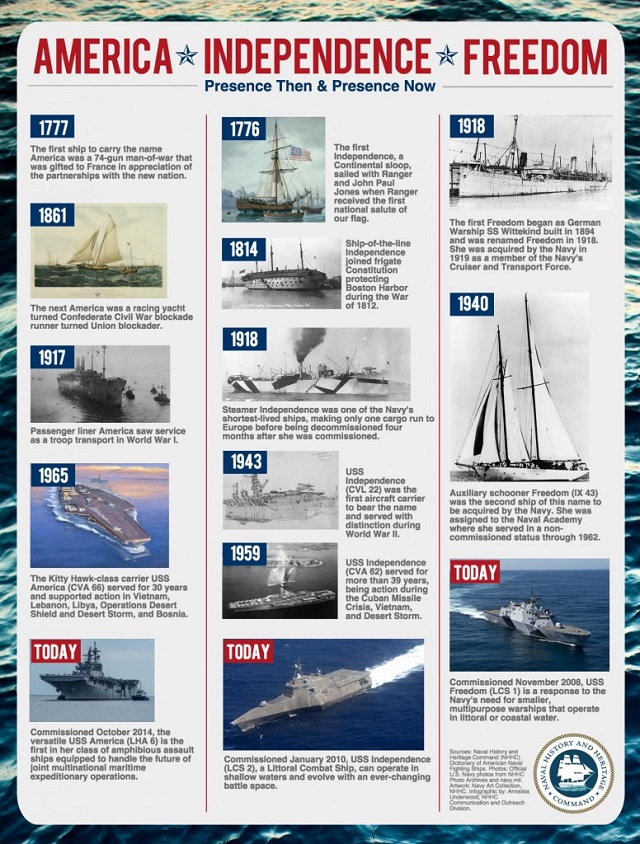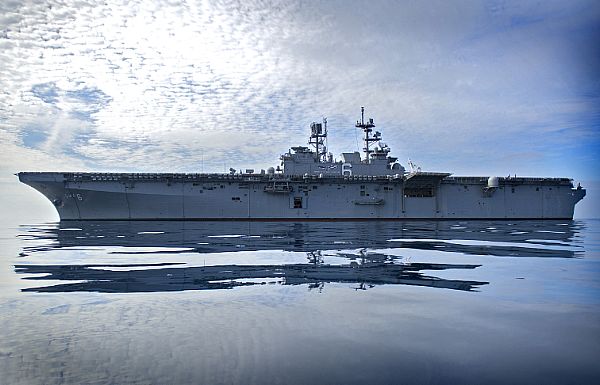Happy Birthday America!
For over 240 years, the U.S. Navy has been a cornerstone of American security and prosperity, providing integrity, accountability, initiative and toughness around the world. Happy Birthday America!
Independence and Freedom
By Joshua L. Wick, U.S. Naval History and Heritage Command, Communication and Outreach Division
When many Americans think of the 4th of July, a few words come to mind: Freedom, Independence, America. These words carry a certain weight; they represent power, strength and fortitude. So it’s no wonder why some of the greatest U.S. Navy ships have born these names.
Since the establishment of America’s Navy there have been very few years in which Sailors were not actively serving aboard ships with these names. To truly know these Sailors, we need to know their ships – as it is their ships bear witness to their selfless service to the country. The 4th of July, the anniversary of the birth of American freedom and independence, is a great time to reflect on the ships that have carried those names to the far corners of the earth in defense of America, freedom and independence.
The History of Navy’s ‘America’
The first ship to carry the name America, a 74-gun man-of-war, was laid down in May 1777. She never served the nation of her namesake; upon completion of construction she was gifted to France in appreciation of the partnerships with the new nation.
The next ship was a racing yacht turned Confederate Civil War blockade runner turned Union blockader. Then passenger liner America saw service as a troop transport in World War I.
The next in the line and the most famous to date is the Kitty Hawk-class carrier USS America (CVA 66). Her 30 years of service is just as interesting as her sinking. Her active service included deployments to in support of action in Vietnam, Lebanon, and Libya, as well as Operations Desert Shield, Desert Storm, and U.N. peacekeeping efforts over Bosnia.
After retirement, America served her Navy by being sunk during a live-fire test and controlled scuttling ultimately helping naval shipbuilders and engineers better understand ship survivability. Lessons learned have been incorporated into following ship designs.
.jpg)
Arriving in New York Harbor, with her decks crowded with troops returning home from France, 1919. Photographed by E. Muller, Jr., New York. Donation of Dr. Mark Kulikowski, 2007. U.S. Naval Historical Center Photograph.
.jpg)
USS America (CV-66) Underway in the Indian Ocean on 24 April 1983. Photographer: PH2 Robert D. Bunge. Official U.S. Navy Photograph, from the collections of the Naval History and Heritage Command.
The ‘America’ We Know Today
Commissioned in October 2014, USS America (LHA 6), is first in her class and unlike any other amphibious assault ship in the fleet. She is specifically designed and built for flexibility of operation, energy efficiency and is able to handle the future of joint multinational maritime expeditionary operations. The ship and her Marine Corps elements can support small-scale contingency operations of an expeditionary strike group while remaining adaptable to new platforms like the F-35B Joint Strike Fighter and MV-22B Osprey.
PACIFIC OCEAN (Feb. 19, 2015) The amphibious assault ship USS America (LHA 6) is underway off the coast of San Diego preparing for final contract trials
The History of Navy’s ‘Freedom’
The Navy’s first ship to be called Freedom actually started as the German ship, SS Wittekind, built in Hamburg, Germany in 1894. She was seized by the United States Shipping Board in 1917 and renamed Iroquois. First chartered by the Army as a transport vessel she was renamed Freedom (ID 3024) in 1918. Shortly after she was acquired by the U.S. Navy on January 24, 1919 she only operated briefly as a member of the Navy’s Cruiser and Transport Force before she was decommissioned in September 1919.
The second Freedom (IX 43) was an auxiliary schooner, acquired by the Navy in 1940. She was assigned to the Naval Academy where she has served in a noncommissioned status through 1962.
.jpg)
In port in 1919, while engaged in transporting U.S. troops home from France. Note inscription at the bottom of the image: U.S.S. Freedom, the ship that brought me home. Courtesy of Donald M. McPherson, 1970. U.S. Naval Historical Center Photograph.
The ‘Freedom’ We Know Today
USS Freedom (LCS 1) is a response to the Navy’s need for smaller, multipurpose warships that operate in littoral or coastal water. In addition to operating in the shallows, Littoral Combat Ships are designed to evolve with an ever changing battle space and can be reconfigured for surface warfare, anti-submarine warfare and mine countermeasures missions. Limited crew requirements, speed exceeding 40+ knots, and maneuverability make Freedom a flexible combatant.
On February 16, 2010 Freedom made her maiden deployment to the Caribbean and Eastern Pacific via the Panama. More recently, in May 2014, Freedom successfully conducted the first combined at sea operation between an unmanned MQ-8B Fire Scout and manned SH-60 Seahawks.
.jpg)
PACIFIC OCEAN (April 28, 2015) The littoral combat ship USS Freedom (LCS 1) transits alongside the aircraft carrier USS John C. Stennis (CVN 74) in preparation for a replenishment-at-sea training exercise. U.S. Navy ships are underway conducting an independent deployer certification exercise off the coast of Southern California.
The History of Navy’s ‘Independence’
.jpg)
At anchor, while wearing dazzle camouflage, circa 1918. This photograph may have been taken in the San Francisco Bay area, California, before she was taken over by the Navy. She was built in 1918 at San Francisco as SS Independence. U.S. Naval Historical Center Photograph.
Of the three names in this post, the name Independence has graced more ships than the other two. The first Independence, a Continental sloop built in Baltimore, Md., was sailing with Ranger and John Paul Jones in 1776 when Ranger received the first national salute of our flag.
The next Independence, a ship-of-the-line, was commissioned in June 1814 and immediately joined frigate Constitution protecting Boston Harbor during the War of 1812. Over the course of the next 99 years, she was brought in and out of service (mostly in) until finally decommissioning just two years shy of the 100th anniversary of her launching.
From one of the Navy’s longest-lived ships, to one of its shortest-lived, the next Independence was a steamer commissioned November 16, 1918 that made one cargo run to Europe, returning to the state and decommissioned just four months and four days later on March 20, 1919.
Two aircraft carriers have born the name. The first, (CVL 22), was commissioned January 14, 1943 and served with distinction during World War II. The fifth Independence, (CVA-62), was commissioned January 10, 1959 and served for more than 39 years seeing action in the Cuban Missile Crisis, Vietnam and Desert Storm before being decommissioned September 30, 1998.
The ‘Independence’ We Know Today
The sixth ship to bear the name is USS Independence (LCS 2). Commissioned in January 2010, her unique design and use of interchangeable technology, like USS Freedom (LCS 1), allows for operational flexibility supporting various mission requirements. In April 2012, she passed through the Panama Canal for the first time, trained with the Mexican Navy, and accomplished her first visit to a foreign port when she put in to Manzanillo, Mexico where her Sailors participated in a community outreach project.
.jpg)
PACIFIC OCEAN (July 23, 2014) The littoral combat ship USS Independence (LCS 2) transits during Rim of the Pacific (RIMPAC) 2014.
For most of the 239 years since America seized freedom and declared its independence, our Navy has included ships that go by those names; lasting symbols of their namesakes and reminding us all of the historic document boldly signed by our nation’s founding fathers on that fourth day of July day in 1776.

The opinions expressed herein are the author's and not necessarily those of The Maritime Executive.

